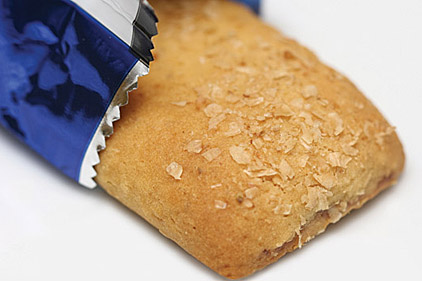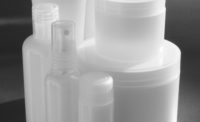Natural rubber is a polyisoprene produced by Hevea trees that consists of approximately 99% cis-1,4 repeating units. Natural rubber latex (NRL) has been used in cold-seal adhesive formulations for over 100 years. The term “cold seal” describes an adhesive that bonds to itself under pressure at ambient temperature without adhering to other materials. Cold-seal adhesives (CSAs) are ideal for bonding heat-sensitive substrates, such as plastic film, since no heat is required for bond activation. They are also capable of bonding many additional substrates, including film, foam, paper, foil and linerboard.
in cold-seal adhesive formulations for over 100 years. The term “cold seal” describes an adhesive that bonds to itself under pressure at ambient temperature without adhering to other materials. Cold-seal adhesives (CSAs) are ideal for bonding heat-sensitive substrates, such as plastic film, since no heat is required for bond activation. They are also capable of bonding many additional substrates, including film, foam, paper, foil and linerboard.
CSAs made with NRL are commonly used in the manufacture of medical devices and food packaging products due to NRL’s excellent flexibility, high initial tack, and good tack retention properties. However, NRL has several notable disadvantages that are causing manufacturers to look at NRL-free formulations.
NRL DISADVANTAGES
NRL can contribute to allergic reactions due to the presence of certain natural latex proteins. Therefore, manufacturers and service providers are feeling the pressure from regulatory bodies in Europe, the U.S. and Japan to find alternatives. This effort is under way to protect patients, healthcare workers, food handlers and consumers from products that contain NRL. Some people know they have an allergy to NRL and take measures to prevent exposure, but others only find out after a reaction. The best approach to protect people from exposure is to avoid the use of NRL products in the first place.
Another disadvantage of NRL is that it readily oxidizes and discolors at relatively low temperatures. NRL formulations require preservation against bacterial attack via the incorporation of a fungicide, and they also suffer from raw material variation.
DEVELOPING ALTERNATIVES
In recent years, several cold-seal adhesive systems that claim superior properties to natural rubber have been developed. Some have blends of natural rubber and synthetic latex, such as acrylic or vinyl acetate ethylene. However, development has also included completely non-natural rubber formulations using synthetic polymers, copolymers, and polymer mixtures, including acrylic copolymers and styrene butadiene rubbers.
Blends of two or more different polymer types are commonly used in new cold-seal adhesive formulations. Often, one component is a polymeric dispersion (e.g., acrylic copolymer) and the second is an elastomer (e.g., styrene butadiene rubber). It is believed that when the cold-seal adhesive is applied and dried, the more adhesive portion of the formulation orients toward the film, while the cohesive portion orients toward the surface. In this way, the formulator has a strong tool to independently “dial-in” adhesive and cohesive properties.
Many applications for flexible packaging adhesives require compliance with regulations for direct or non-direct food contact (e.g., from the U.S. Food and Drug Administration, or FDA). An adhesive, coating or ink used in the packaging of a food item for human consumption must conform to applicable regulations. The U.S. FDA 21 CFR175.105 covers the use of adhesives for indirect food contact. Specific regulations governing a particular application are usually available.
In Europe, the relevant regulatory requirements are covered under Commission Regulation EU No 10/2011 (on plastic materials and articles intended to come into contact with food) and the German BfR (Budesamt fuer Risikobewertung) Regulation XXI (commodities based on natural and synthetic rubber).
RESPONDING TO MARKET DEMAND
Adhesive manufacturers and downstream food and medical packaging companies alike are greatly interested in moving away from NRL. However, the drivers for interest are quite different in these two marketplaces. While allergy reduction is the main driver in medical packaging, the most commonly identified drivers in the food packaging industry include the fluctuating quality of NRL, which can impact line speed and productivity, and, more recently, the very high prices for NRL, which have increased nearly five-fold over the past two years before relaxing again in the second half of 2011. In the early part of 2012, prices have started to increase again toward the $4,000/ton mark. The low/neutral odor of NR-free products is another driver to move away from NRL.
In response to these changes in the market, various food and medical packaging manufacturers are looking to alternative materials* to replace the NRL in their products. One such material** is produced by using an initiator to polymerize isoprene monomers. It comes as a solid rubber or in latex form and has a proven track record as the replacement product-of-choice for natural rubber products in medical sectors including gloves, condoms, and stoppers.
The natural rubber-free material serves as an ideal alternative for applications that demand extreme purity, exceptional protection and consistently high quality. These products offer a pure and versatile option for manufacturing applications that require the high tensile strength and tear resistance of natural rubber without the impurities that cause discoloration, odor, and allergic reactions.
*Cariflex(TM) polyisoprene products, a product of Karton Performance Polymers.
**Cariflex IR
For more information, call (800) 457-2866 or visit www.kraton.com.




